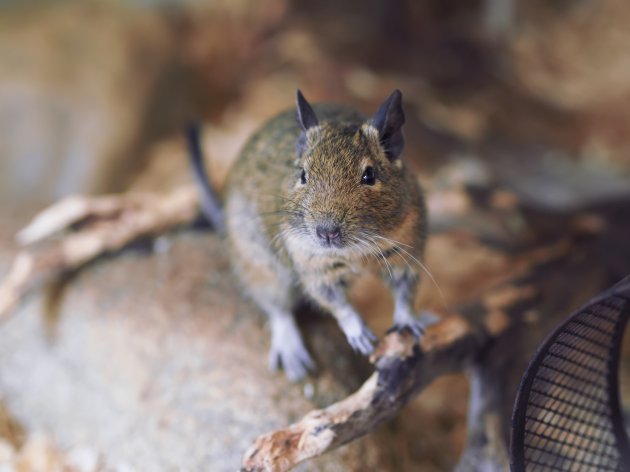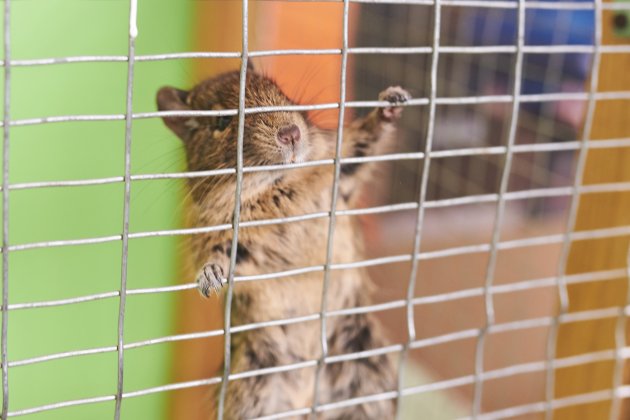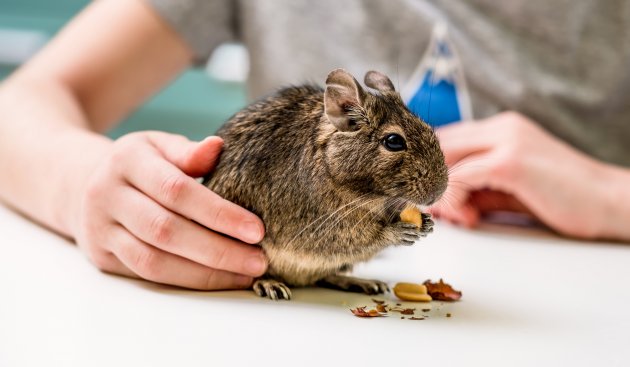You may already know what a Degu is; however, for those of you who don't, this sociable rodent is related to the guinea pig and chinchilla. In its natural habitat, the species is found in Chile from the coastal plains to the Andes Mountains. It lives in small groups of 5 to 10 individual rodents, which then make up complex burrows of around 100 members.
This rodent obviously loves the company of other Degus, so what would it be like as a pet?
Let's discover the ins-and-outs of keeping a Degu as a pet.

The Appearance of the Degu
The degu is a cute rodent with soft, yellow-brown fur and a paler underbelly. It grows from 5 to 7 inches in length, with a 6-inch short fur-covered tail. Degus weigh from 6 to 10 ounces and can live up to 10 years.
It has tiny claws on each toe (designed for burrowing) and large triangular ears. Its eyes are also big and black. Healthy Degu teeth are yellow to orange, with cheek teeth in a figure-eight formation.
Can You Keep a Degu as a Pet?
Yes! Degus can make wonderful pets. However, due to their social nature, it is highly recommended the Degu be kept in same-sex pairs.
Although Degus are wary of people at first, with respect, love, treats, and kind handling your Degu will begin to bond with you. Unlike some other pet rodents, the Degu is diurnal, meaning it is more active during the daytime hours, especially first thing in the morning and the evening.
The Personality and Temperament
Degus are easily tamed when handled from a young age. They are playful critters with a need for both human and other degu interaction. Without this, the lonely degu can become neurotic and even aggressive.
If you’re lucky, your degu will communicate with you with sweet chitter-chatter. The species can also emit a high-pitched “scream;” however, this usually only happens when the degu is stressed, or someone has taken its food.
One of the great things about a pet degu is once it has bonded with its pet parent, it will come for belly scratches or to be cuddled.
NEVER pick your degu up by the tail, as it can come off. This is a natural defense mechanism for this animal, which it uses in the wild to escape predators. The trouble is it is painful when it happens, and the tail never grows back.

How Do You House a Pet Degu?
Degus need a large wire enclosure (to prevent these animals from chewing through the cage) It should measure in at a minimum of 24 inches by 18 inches by 24 inches. However, in the case of the degu cage, bigger is always better - think multi-level cages designed for ferrets or chinchillas. The bottom of the unit should be solid (not grated), so you can supply your degu with burrowing material like peat, dust-free material, and bark chippings mixed together.
The pet degu will also need a nesting box to help replicate its natural burrow. This can be made from wood with a flat roof, measuring 6 by 8 inches in diameter. The pet degu will also appreciate nesting material in the box in the form of tissue, paper towels, shredded (ink-free) paper, or hay. DO NOT use pine or cedar shavings as these can be toxic to your pet.
Degus are avid chewers, so you will want to give your pet, appropriate objects to satisfy this habit. A variety of wooden blocks and toys designed for rodents or large parrots are excellent choices, as are willow balls and mineral or salt blocks.
Degus and Climate
Degus are prone to overheating and even heat stroke. For this reason, your degu should be housed in an ambient temperature of 20 degrees Celsius - any warmer and your pet can become stressed. This animal doesn’t mind the cold but dislikes wetness or damp conditions.
Feeding Your Pet Degu
Degus cannot digest sugar or carbohydrates (and are prone to diabetes), so be sure to stick to food that is appropriate for this rodent. Commercial pellets made for chinchillas or guinea pigs with a rodent block is an excellent staple for the degu. You will also want to make nutrient-rich grass (alfalfa and Timothy grass) available at all times. A great way to do this is by stuffing it into a box and allowing your degu to forage for it.
You can also supplement your degu with fresh veggies, which includes;
- Carrots
- Raw sweet potato (be sure to remove the skins as it can be toxic)
- Spinach
- Parsley
- Green beans
- Dandelion leaves (only pesticide-free and in small quantities as a special treat)
Avoid vegetables like broccoli, kale, cabbage, and Brussel sprouts and fresh fruit (too high in sugar). For a very special treat, whole nuts in the shell, sunflower seeds, and peanuts may be offered, but not too many as these are high in fat.
Of course, as with any animal, clean water should be provided at all times. Use either a heavy ceramic bowl or a water bottle with a chew-guard in place.

Tips on Keeping a Pet Degu
One of the special considerations of the pet degu is the proper amount of both physical and mental stimulation it needs. To help combat boredom in the pet degu, provide your pet with an exercise wheel that measures around 10 inches in diameter. Clay piping for tunneling, sisal, corn, or jingle balls for playing and a digging box filled with organic sand or soil are also excellent ideas.
To satisfy your degus need to gnaw, pop in sticks made from oak, pear, apple, ash, or beech trees.
The pet degu will also need a regular dust bath to prevent its skin from drying out. Put a shallow dish with from one to two inches of chinchilla dust in the pet’s cage. Leave for about ½ hour to allow your degu to roll around in it. Remove and repeat the process every few days.
Fun Degu Facts
Whether you want to keep a degu as a pet is up to you. But either way, check out these fun degu facts!
- In nature, degus all work together to build a huge underground structure with dozens of tunnels leading to different living quarters.
- Their homes include nurseries for the babies, sleeping areas, and places to store the food.
- Degus form “digging chains” to get these living quarters built.
- All the females take part in raising the young, and will even nurse each other's offspring.
- In the wild, degus eat a variety of seeds, leaves, and grass.
- Studies show degus are very intelligent. They develop trust, problem-solving skills, and empathy. Some have even demonstrated the ability to use simple tools and an understanding of object size.
- Researchers compared the intelligence of the degu to a raccoon.
- Degus are vocal with a range sounds including chuckling, squeaking, and chattering.
Degus & You
If a degu sounds like the right pet for you, do your research to find a reputable breeder or rescue organization. Know these animals MUST be kept in multiples, due to their highly social nature and don’t do well in overly-hot climates. You will also want to provide your rodents with a large enclosure, digging material and toys, branches and an exercise wheel. Having healthy degus can be a rewarding experience for the right pet parents.
References and further reading:
- Degus (Complete Pet Owner's Manuals) by Sharon Vanderlip (2001) (Buy book)
- ScienceDirect, Degu - an overview
- University Of Montana, Degu Husbandry and Care
- ResearchGate, Diseases in pet degus: A retrospective study in 300 animals